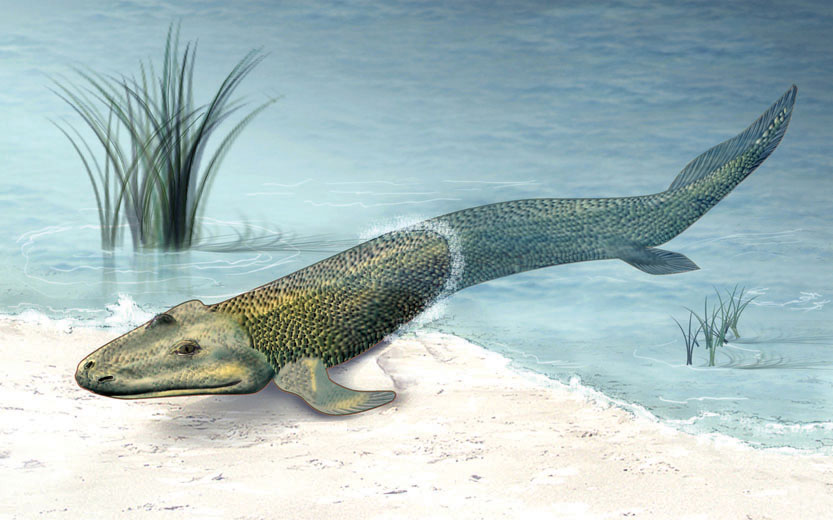THE FISH THAT DID PUSHUPS
Shubin and Daeschler were lucky: the fossils they found were so well preserved that they were able to study Tiktaalik’s skeletal anatomy in detail, even seeing how the bones interacted and where muscles attached. From these fossil bones, they determined that Tiktaalik was a predatory fish with sharp teeth, scales, and fins. In addition to these fishy attributes, it had a flat skull reminiscent of a crocodile head and a flexible neck. To Shubin and Daeschler, the neck was one of the most surprising finds. Having a flexible neck meant that, unlike a fish, Tiktaalik could swivel its head independently of its body, perhaps enabling it to catch a glimpse of predators sneaking up on it from behind or to snap its jaws sideways like a crocodile. It also had the full-fledged ribs of a modern land animal, sturdy enough to support the animal’s trunk out of water even against the force of gravity.
 It looks like a fish in that it has scales and fins, but when you look inside the skeleton you see how special it really is.
It looks like a fish in that it has scales and fins, but when you look inside the skeleton you see how special it really is.
— NEIL SHUBIN

But it is Tiktaalik’s fins that have justly made it famous. While possessing many features of a lobe-finned fish, Tiktaalik appears also to have had a jointed elbow, wrist, and fingerlike bones. From the fossil pieces, Shubin and Daeschler were able to create a model of how the bones would have moved relative to one another, and they have modeled these movements digitally. The models show that the bones and joints were strong enough to support the body and worked like those of the earliest known tetrapods—the early amphibians. “This animal was able to hold its fin below its body, bend the fin out toward what we think of as a wrist, and bend the elbow,” explains Daeschler. In other words, it was a fish that could do a push-up.
With this hybrid anatomy, Tiktaalik was not galloping on land, of course. It probably lived most of the time in water, but Shubin and Daeschler suspect that Tiktaalik may have used its supportive fins to pull itself out of the water for brief periods. “This is a fish that can live in the shallows and even make short excursions onto land,” said Shubin, in the same 2006 interview. The ability to crawl onto land would certainly have been a useful trait in the Devonian, when open water was a brutal fish-eat-fish world, whereas land was a predator-free paradise, full of nourishing bugs.
Like other fish living at the time, Tiktaalik is thought to have had both lungs and gills, which explains how it could breathe out of water for these short excursions. Most modern fish have retained their gills but lost their lungs over time (the lungs have evolved into the balloon-like structure known as a swim bladder, which helps fish float). Some modern fish known as lungfish, however, have retained this ancestral trait. Lungfish are lobe-finned fish closely related to the lobe-finned fish from which Tiktaalik is believed to have descended.
There was, of course, no forethought involved in this process of limb evolution. Fish did not develop limbs for the purpose of walking on land. Rather, limbs first evolved in shallow water, where they proved adaptive and were thus retained in the descendants of the organisms who first developed them. Then, when there was an opportunity to take advantage of a tantalizing new habitat—land—the amphibious creatures already had the skeletal “toolkit.”
For all its amphibian-like adaptations, Tiktaalik is still considered a fish because its limbs lack the true jointed fingers and toes that characterize tetrapod limbs (in other words, they’re still fins). But it’s by far the most tetrapod-like of all the fishes so far discovered. Scientists have jokingly referred to it as a “fish-apod” (INFOGRAPHIC 16.4).
Tiktaalik possesses adaptations of both fish and tetrapods. For all its amphibian-like characteristics, Tiktaalik is still technically a fish because its limbs lack true jointed fingers and toes, a defining feature of tetrapods.

And that’s what makes Tiktaalik such an important find: it occupies a midpoint between fish and tetrapods. “It very much fits in that gray area between things we typically call fish and things we typically call limbed animals,” says Daeschler. Such intermediate, or transitional, fossils document important steps in the evolution of life on Earth. They help biologists understand how groups of organisms evolved, through natural selection, from one form into another. And they confirm that Darwin’s theory of descent with modification—which predicts such intermediate forms—is correct.